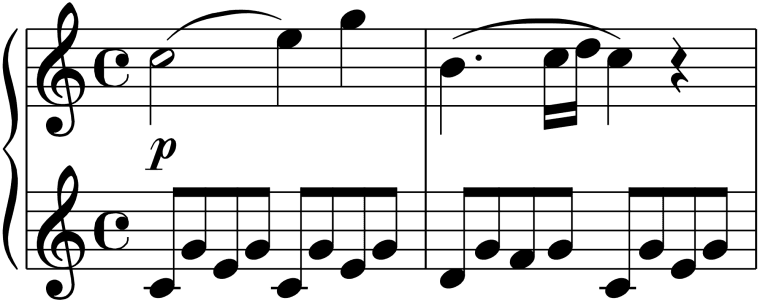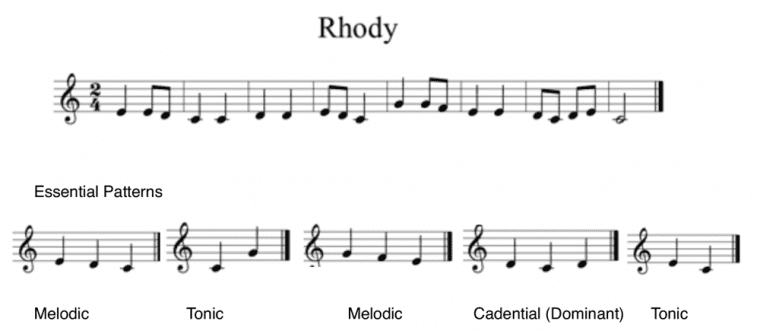I’m very happy that Barb Grout, a blog reader and Music Learning Theory teacher, has taken the time to write today about the importance of teaching musical patterns and how to incorporate it into your studio.
I’ve called it the Ultimate Guide to Teaching Patterns, following the Music Learning Theory approach.
Patterns are the vocabulary of music. If we don’t give students a rich musical vocabulary, how can we expect them to “speak” (or read) music with confidence and flow?
If you’ve been wondering what pattern-based teaching looks like in practice, then this Ultimate Guide is for you. You might also like to check out the Podcast I recorded with Jo Burrows about teaching patterns in piano lessons.
It always makes my day and warms my heart when my students “get it,” when they experience an “ah-ha” moment, when understanding dawns, when recognition lights up their eyes. It’s the reason I still love teaching music after thirty years.
One of those moments occurred in a recent lesson when sisters Georgie and Carly were working on their duet, Falling Leaves. They were just wrapping up eight measures of improvisation.
At that moment, Carly, playing the primo part, heard her sister’s secondo part change. Her eyes lit up as if to say, “I know what to do now!”
At that moment she resumed playing the written melody—in sync with her sister’s bass part—and they finished the piece together. It was tight. It was musical. It was wonderful. And they knew it.
They were so excited they both jumped off the piano bench and took a bow to the only person in the room—me! Carly, age four, and Georgie, age six, had just had a breakthrough in their understanding of music. They had just become a little more musically literate. Because they could feel it, they understood when to make the change.
All music teachers want to provide a firm foundation in music literacy for their students. It’s what we do.
For over thirty years I have gone about this in many different ways, using a variety of methods and techniques, some reasonably successful, some less so.
Six years ago I discovered Music Learning Theory, the teachings of Dr. Edwin Gordon, and it has transformed the way I help students become musically literate.
Most importantly, it has helped my students, even the youngest ones, truly understand the music they’re playing, not just decode the notes on the page.
So what’s Music Learning Theory all about? Here are the basics in 5 minutes:
Try reading the next paragraph.
I’st asomlt ismsopilbe to blveiee taht yuo cluod aulaclty raed waht yuo aer sieneg! Btu rsceearh ta Cmbargide sohws, ti dsne’ot mtaetr in waht oerdr teh ltteres ni a wrod aepapr. Ti cna eb a taotl mses adn yuo cna sitll raed ti wtih vrey ltitle pboerlm. Tihs is bcuseae raednig is nto dnoe lteter by lteter, btu sa wlohe petratns.
Could you make sense of it?
Most likely you could—but not if you tried to decode it letter by letter.
So how did you make sense of it? By recognizing combinations or patterns with which you were familiar.
Similarly, when music students try to decode a piece of music note by note, the result doesn’t make sense as music. It’s not musical; it doesn’t flow.
The point is that in language, as in music, we read patterns. It’s the recognition of the patterns that gives meaning to written language and to music notation—not the individual letters or notes. This is one of the foundational ideas in Music Learning Theory.
So, let’s talk more about teaching musical patterns.
Every piece of music has a foundation of rhythm patterns and tonal patterns.
In order to explore these ideas, we’re going to look at a simple tune called Go Tell Aunty Rhody:

Rhythm patterns are the rhythmic road signs in a piece of music. Typically, a rhythm pattern can be found in just two to four measures in any piece and includes macrobeats (also called pulse beats or big beats), microbeats (also called meter beats), and a section of the melodic rhythm.
A great exercise for students is to have them find where, in a piece of music, the essential rhythm patterns are repeated. For example, here are two patterns in duple meter found in Go Tell Aunt Rhody (see Example 1):

Here’s an example of other common rhythm patterns in contemporary music and how you can teach them:
Tonal patterns provide a shorthand harmonic outline of the song. (In major mode, this would be the tonic, dominant, and subdominant chords.)
Tonal patterns consist of two, three, and sometimes four pitches. To be understood by the students, they must be taught in the context of a tonality—major, minor, phrygian, dorian—or whatever mode the piece is in.
These are examples of patterns in major mode:


While not strictly a part of the Music Learning Theory approach, giving students an understanding of left hand patterns they are likely to encounter is crucial to their ability to read and understand music.
Take, for example, the following two ubiquitous patterns.
The first, used widely in classical music, is called an Alberti Bass. All students should recognise this as a broken triad, and be able to play it instantly:

Secondly, here is one of the most popular LH patterns used in contemporary, pop, film and modern music today:

There are, of course, many more common patterns which students should be able to recognise and play without having to work out all the notes (that’s the point of reading the pattern as a musical “word”).
To find out more about LH Patterns, please check out my Ultimate Guide to LH Patterns from where you can download a free guide to all the most common patterns. I use this just about everyday in my teaching. If you’re doing any work with chords or lead sheets, this is the guide to get.
Here are a few resources you might like to explore about these kinds of patterns:
I would recommend exploring them by playing them in alternate positions around the piano. Get students to improvise over them. Use learning them as drills and warm ups. Make simple chord progressions out of them.
The better students learn to recognise, improvise and play patterns like these, the better.
Here are the steps to finding the essential tonal patterns in major and minor modes:
When students sing the tonal patterns sequentially, they really “get” the piece they are learning. The understanding is deep and lasting.
Here are examples of the essential tonal patterns in Go Tell Aunt Rhody:

Learning tonal and rhythm patterns develops a large musical vocabulary.
Patterns are to music what words are to language: a vocabulary. How can you speak a language without a vocabulary? – Tim Topham.
A large vocabulary creates effortless sight-reading, especially when students “play” with the patterns through chanting, singing, and then improvisation until they become familiar with them.
The more differences children hear—major, minor, dorian, phrygian, lydian modes, etc., as well as duple, triple, and other meters—the better their understanding of music.
Children understand the tonal dimensions in music when they learn to organize pitches into functional tonal patterns that relate to a tonal center. – Eric Bluestine

So how do you teach musical patterns? By using the same basic method that babies use when they are learning their native language.
Here’s how babies do it:
Just as with learning one’s native language, there are five steps to music fluency and literacy:
Related: Audiation in Action with Andy Mullen (Podcast with Video)
In summary, here are the parallels between language learning and music learning:
“If words, not sentences, are the start of a baby’s listening vocabulary, what does that tell us about appropriate music development? It is not songs that develop the music listening vocabulary. It is tonal patterns and rhythm patterns.” – Dr. Edwin Gordon

Related: Exploring Music Learning Theory with Marilyn Lowe (Podcast with Video)
Watch this video as Andy Mullen demonstrates what pattern-based audiating, singing and teaching actually looks like in a Music Learning Theory lesson.
Students love to play with music in this way! They learn their pieces very deeply and they enjoy the process.
For older students, Music Moves for Piano: The Well Tempered Reader series by Marilyn Lowe (GIA Music) provides step-by-step instruction to help students develop audiation-based reading.
The pieces are late elementary to early intermediate from baroque to romantic periods and written in fifteen major and minor keys.
I always know when students have not yet developed the best tonal- and rhythm-pattern foundation.
When they see a brand new piece of music, they look at it as if it is a foreign language. They don’t know what meter they’re playing in, and their rhythms are erratic. They write the names of the notes in their music and try to decode the piece note by note.
They don’t play musically. They don’t see the similarities between this piece and a previous one they played.
Does this sound familiar?
In contrast, Georgie and Carly can easily point out similarities between their old and new pieces—without prompting. That’s because they learn each new piece by comparing its patterns to the one they learned before.
When students make comparisons, they learn faster and with understanding. Carly’s and Georgie’s improvisations on Falling Leaves were based on rhythm patterns that they had chanted before they sat down at the piano, which helped them feel when the eight bars of improvisation were finished.
That also will help them feel the phrasing in other pieces of music. Georgie and Carly are not ready to read music just yet, but when they are, I know they’ll be hearing the printed page before they play.
And their teacher will have a big smile on her face.
That’s the power of patterns.
* This guide evolved from an article that first appeared in Clavier Companion. Expanded and developed with permission.
What’s your approach to teaching patterns? Have you started focussing more on them in your studio since our July Theme of Music Learning Theory?
What music do you like to use for pattern-based work?
Let us know what has worked in your studio by leaving a comment below.

Jake says:
Hi Barb, I have a question
You wrote this: “Rhythm patterns are the rhythmic road signs in a piece of music. Typically, a rhythm pattern can be found in just two to four measures in any piece and includes macrobeats (also called pulse beats or big beats), microbeats (also called meter beats), and a section of the melodic rhythm.”
Are you saying that a rhythm pattern exists only within 2-4 measures of any piece, or instead that one can identify a rhythm pattern by listening to 2-4 measures of the song?
Thanks and great article!
Marilyn Lowe says:
Great article, Barb – so well written. As always you pointed out the relevancy of tonal and rhythm patterns. They do make the difference.
Andy says:
Hey Barb,
Great article!! I really loved a lot of your links, especially “Contemporary Accompaniment Patterns.” I think my advanced piano students will find it very useful.
Cheers!
Andy